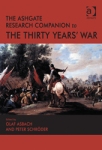Olaf Asbach and Peter Schröder, editors. The Ashgate Research Companion to the Thirty Years’ War. Burlington, Vermont: Ashgate Publishing, 2014. ISBN 978-1-4094-0629-7. Notes. Bibliography. Index. Pp. xv, 347. $149.95 (hardback).
Originally published in The Journal of Military History (October 2014)
 The Thirty Years’ War is a fascinating albeit complex subject for students and scholars. Even so, the series of conflicts known as the Thirty Years’ War continues to attract the attention of historians. In the present study, a group of twenty-seven international scholars address some of the latest research, not always available in the English language. This collection of essays is edited by Olaf Asbach, Professor for Political Science at the University of Hamburg and Peter Schröder, Senior Lecturer in Early Modern History at University College London. They provide a valuable introduction essay.
The Thirty Years’ War is a fascinating albeit complex subject for students and scholars. Even so, the series of conflicts known as the Thirty Years’ War continues to attract the attention of historians. In the present study, a group of twenty-seven international scholars address some of the latest research, not always available in the English language. This collection of essays is edited by Olaf Asbach, Professor for Political Science at the University of Hamburg and Peter Schröder, Senior Lecturer in Early Modern History at University College London. They provide a valuable introduction essay.
The origins of the conflict, status of the great powers, making and breaking of coalitions, conduct and experience of the war, and peace settlements are discussed in twenty-five essays. Setting the historical background, Joachim Whaley and Brennan Pursell provide essays on the politics of the Holy Roman Empire and the Palatinate. The next seven essays address the great powers and coalitions of the Thirty Years’ War. In his essay, Christoph Kampmann puts new light on the role of Austrian Habsburg Emperors Ferdinand II (r.1619-37) and Ferdinand III (r.1637-57). The actions of their ally, the Spanish Habsburgs, in central Europe and northern Italy are explored by Gabriel Guarino. Christian IV of Denmark’s (r.1588-1648) reasoning to take action as a prince of the Holy Roman Empire against Imperial forces and the outcome is discussed by Paul Douglas Lockhart. Pärtel Piirimäe examines Gustav Adolf’s (r.1611-32) invasion of the Empire in 1630, and the Swedish role throughout the rest of the conflict. Lucien Bély explores the role of France in the War of the Mantuan Succession (1628-31), the alliance and financial support of Sweden from 1630, and active involvement in the war, as an ally of Sweden, against the Spanish and Austrian Habsburgs from 1635 on. The struggle against the Emperor ended at the Peace of Westphalia (1648), but the Franco-Spanish War continued until the Peace of the Pyrenees (1659). Next, Guido Braun explores Papal diplomacy and its part in mediating the conflicts. Maria Baramova rounds out the picture of the role of the great powers by assessing the reasons why the Ottoman Empire remained aloof from the Thirty Years’ War.
The next five essays discuss the different stages and theaters of the Thirty Years’ War. In his essay, Ronald G. Asch focuses on the conflict from the outbreak of the war (1618) in Bohemia to the Edict of Restitution (1629). He relates the Catholic League’s victory over Frederick V of the Palatinate at the battle of White Mountain (1620) in Bohemia. The conflict escalated with the Spanish Habsburgs capturing the Lower Palatinate, followed by Imperial forces defeating Christian IV of Denmark and occupying northern Germany and part of Denmark. Toby Osborne picks up the discussion and explores the spread of the conflict to northern Italy. He also addresses Gustaf Adolf’s invasion of Germany to counter the Imperial threat to Swedish interests. Osborne then describes the success of Gustav Adolf, and, after his death in 1632, the slow breakup of the anti-Imperial forces resulting in the German Peace of Prague (1635). Tryntje Helfferich goes on to relate the Franco-Swedish alliance and military actions in Germany in the so-called “Long War” from 1635 to 1648. Furthermore, while Olaf van Nimwegen explains the continuance of the Eighty Years’ War (1568-1648) between Spain and the Dutch Republic from 1621 onwards, and its part in the Thirty Years’ War, Sven Externbrink expounds on the much neglected Italian dimension of the conflict.
This important collection of writings also includes four essays dealing with religion and politics. They explore the question of whether the Peace of Augsburg (1555) was a failure and led to the Thirty Years’ War, the Edict of Restitution, the clash of interests between German Lutherans and Calvinist states, and the question of whether the conflict was really a religious war. The next three essays focus on the experience and material conditions of the conflict. John Theibault looks at the social and economic structures in central Europe that supplied the troops, weapons, and provisions. Sigrun Haude investigates the experience of the conflict, and Peter H. Wilson tells us about strategy and the conduct of the war. The work finishes with four essays regarding the Peace of Prague and the Peace of Westphalia.
It is difficult for scholars to get their points across in brief essays of a dozen pages or so. As such, the scholars in this collection of essays succeeded in their endeavor of enlightening the reader of the latest research on various topics. Aspects of the Thirty Years’ War is a valuable contribution to the historiography of the Thirty Years’ War.
Dr William Young
Grand Forks, North Dakota
